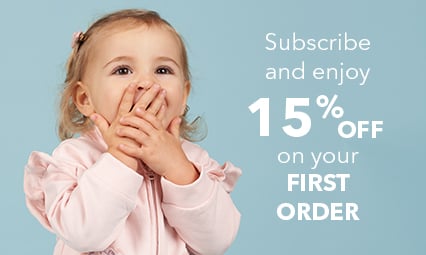How to choose the right size or shoe size for your baby?
Knowing which size clothes truly corresponds to the size and age of your little one is not always easy! Indeed, each child has his or her own body type and shape which means that the age indicated on clothes labels are not very useful… And the same goes for shoes! However, there are some tips that will help you find and choose the most suitable clothes for the weight and stature of your baby. Follow the guide and see!
Choosing the right size clothes
Most often, the labels on DPAM baby clothes mention age and size in centimetres which will help you make far fewer mistakes. But in order to refer to them with confidence, you first need to take your child’s measurements.
Taking your child’s measurements
Before referring to labels, you need to start by taking your child’s measurements. If your baby is younger than 2 years, measure his or her height in lying position. For children older than 2 years, you can measure them in standing position. It is also important to measure the head circumference, hips and waist size. Once you know these measurements, you are ready to choose the right size.
The choice of size
Toddlers grow very fast which is why it is generally recommended to buy one size bigger than their actual size. They can also enjoy their clothes for longer. However, this advice is valid for the following clothing items only:
- Trousers and dungarees;
- Cardigans, jumpers, shirts and tee-shirts;
- Dresses and skirts;
- Jackets, blazers or coats.
When it comes to underwear, however, choose the exact size. Bodysuits, socks and tights must fit perfectly to be comfortable.
Choosing the right shoe size
As with the choice of clothes, your baby’s little tootsies grow very fast. However, a few tips can help you to be sure of choosing the right size shoes in line with your baby’s age.
Shoe size
Children’s feet do not stop growing, especially during the first months of their lives. They generally grow one shoe size every 3 months during the first 3 years, then one shoe size every six months until the age of 8. Armed with this advice, be sure to check that you can fit one finger between your child’s heel and the heel of your child’s shoe. If your finger doesn’t fit, this means the shoes are too small.
The growth margin
You can also make your choice by taking the “growth margin” into consideration. This tip consists of placing your child’s food against a wall, for example, then placing an object with a straight side against the longest toe. Then measure the distance between the longest toe and heel. Once you have this measurement, it’s recommended that you respect different growth margins, as follows:
- up to 2 years, the growth margin should be 1cm maximum;
- a margin between 1cm and 1.5cm for older children, and especially for closed shoe models. However, the margin must not be greater than 1 cm for open-toed shoes.
For more advice about how to choose your children’s shoes (size, model, etc.), don’t hesitate to consult our guide dedicated to shoes!
